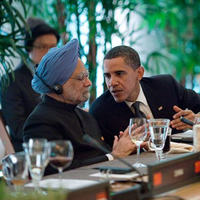Concern about China's emerging economic and military capabilities now drives the U.S. strategic debate. The development of anti-ship ballistic missiles (ASBMs) by the PRC has even led some to argue that the balance of power in the Western Pacific has now shifted in China's direction. At the very least, ASBMs give China another tool with which to threaten U.S. naval predominance in Asia. In response to the perceived growth of Chinese military power, analysts at the Center for New American Security and elsewhere have suggested (.pdf) closer alignment with Japan and India, two of China's regional rivals.
On the surface, this strategy appears similar to that employed by Washington during the Cold War, when the U.S. created circles of regional allies to attempt to hem in the Soviet Union. However, the dynamics of a potential India-U.S.-Japan relationship differ greatly from those that allowed the emergence of NATO. Whereas the United States played the lead military and political role in NATO, it will act more as the connective tissue in the relationship with India and Japan. Also in contrast to the Cold War, the United States might face great difficulty in managing and restraining its regional partners.
On the northern flank of this notional alliance is Japan, which is pursuing an increasingly assertive set of national security policies. Japan's grievances with China include Beijing's continued support for North Korea, as well as territorial disputes over several island chains. The most recent indication of Japan's shifting defense priorities are reports this week that Tokyo will refocus its attention in a southerly direction, developing new mobile units capable of defeating a Chinese incursion onto the disputed islands. Japan's large navy now specializes in missile defense, in part to defend the archipelago from North Korea, but also from China's arsenal of conventional ballistic missiles. Japan is also building several small aircraft carriers -- officially designated "helicopter-carrying destroyers" -- that could become potent force-projection platforms with the addition of the F-35B Joint Strike Fighter. Japan trails China militarily only in the size of its ground forces, in nuclear weapons, and in ballistic missiles. A close relationship with the United States helps to alleviate all of these vulnerabilities.

